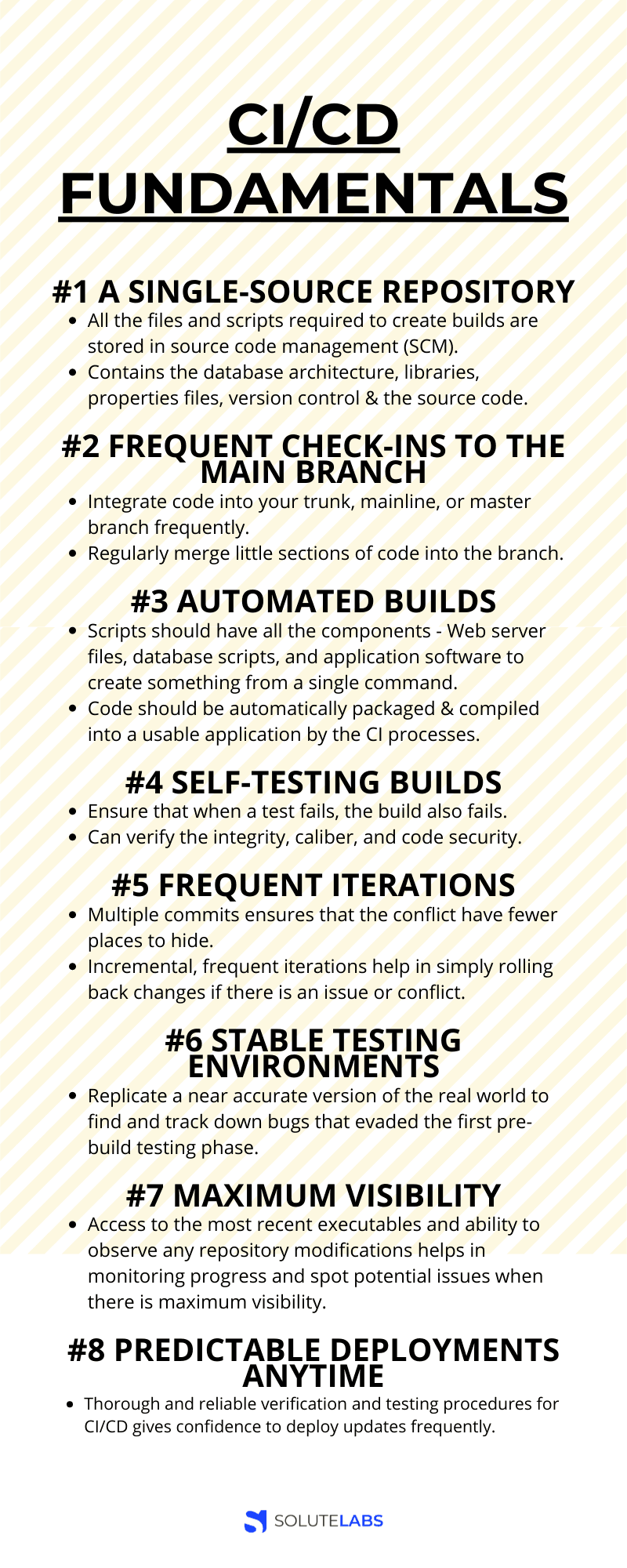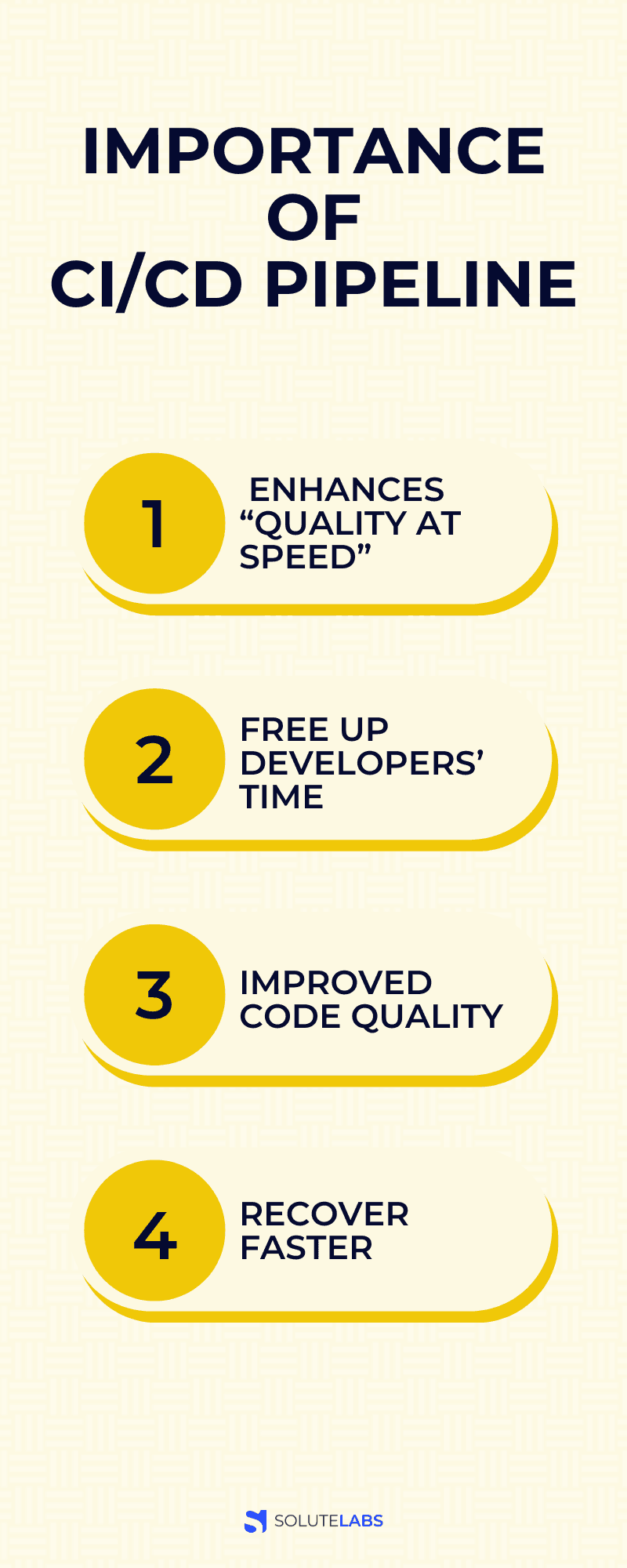CI/CD introduces continuous monitoring and ongoing automation across the whole lifecycle of apps, from the integration and testing phases to the delivery and deployment steps. Development and operations teams collaborate in an agile manner using a DevOps or site reliability engineering (SRE) methodology, and these interconnected processes of Continuous Integration and Continuous Delivery are called a "CI/CD pipeline."
While CD simplifies the release and deployment processes for the operations team, CI optimizes the coding and build processes for the development team.
Now, let’s explore the individual component of the CI/CD method.
Introducing Continuous Integration
Continuous integration (CI) is an automation technology designed to address the difficulties of merging conflicts between the code of many developers and different code branches. To frequently compile code changes, build the application, and test the new version for flaws and problems, CI offers procedures. The updates are ready to move on to the next stage of the development process if they pass the testing suite.
With the agile technique, developers collaborate to share the workload and produce features quickly. However, the likelihood that one update would conflict with another might increase when incorporating more changes.
Continuous Integration Pipelines may solve this problem by routinely integrating changes on a shared branch, sometimes a trunk branch. As opposed to waiting until the end of the coding phase to integrate disparate branches, this approach reduces the likelihood of merge conflicts, and any problems that arise will be simpler and easier to fix.
Following code modification junction, the application is constructed in a demo environment and put through automated testing. By doing this, edits are validated, lowering the possibility that bugs will make it to the delivery and deployment stage.
Evaluate unit tests of individual files & integration tests of the extensive program infrastructure. If errors are found, developers can fix them instantly instead of writing new code on top of a flawed code base.
The CI component is where organizations begin when developing their CI/CD Pipelines. After the merge process has been automated, continuous delivery is the next step.
Continuous Delivery - The Next Step:
The next step in the automation of the software lifecycle is continuous delivery. Code is quickly uploaded to a public repository like GitHub after it has undergone bug testing. By accelerating the delivery of production-ready code, continuous delivery aims to increase visibility and collaboration between the development and operations teams.
The application can then easily be deployed by the operations team. Only when CI is used in conjunction with continuous delivery is it effective. To ensure that code is prepared for release to the repository & testing the CI process is essential. Any other way results in the automatic delivery of flawed code, which introduces defects being pushed into production.
Organizations that have adopted Continuous Integration and Continuous Delivery (CI/CD) Workflows are prepared for the CI/CD pipeline's last evolution: continuous deployment.
Continuous Deployment - The Last Step:
The advantages of continuous delivery are expanded upon by continuous deployment, in which code is now automatically pushed to a repository and subsequently deployed to production in the same process. As a result, the operations team will no longer have to manually deploy new releases, which could be numerous depending on the development team's pace.
However, because this is now the primary failsafe before issues are deployed to production, automating manual deployment methods places an even greater focus on successful test automation during the CI phase.
Continuous deployment speeds up the software development lifecycle with good test design. Since the modifications pass testing, developers can make changes to a feature and have them take effect immediately. It establishes an efficient feedback loop where clients may voice concerns & the development team can respond to them quickly.
In line with the agile technique, continuous deployment enables quick updates that distribute minor adjustments incrementally rather than all at once. These updates are less complex, which reduces the possibility of errors and issues.
Also, Read: DevOps vs Agile: What's the Difference?
Continuous Integration Vs Continuous Delivery:
What about Continuous Integration Vs Continuous Delivery? Continuous integration (CI) is a technique where developers check and make minor changes to their code. This process is automated because of the size of the requirements and the number of steps needed to complete it, allowing teams to design, test, and bundle their applications in a dependable and repeatable manner.
CI streamlines code updates, giving developers more time to make changes and contribute to better products. The automated transmission of finished code to contexts like testing and development is known as continuous delivery (CD). Code delivery to various contexts is made automated and standardized via CD.
The next phase after continuous delivery is continuous deployment. There are numerous production deployments because every modification that passes the automated tests is automatically put into production.
Most businesses that are not bound by regulatory or other limitations should aim toward continuous deployment. In a nutshell, CI is a set of procedures used by developers while writing code, while CD is a set of procedures used once the code has been written. Now that we know the basic difference between CI/CD in DevOps, let’s move to the fundamentals of it.
CI/CD Fundamentals:

Eight key components of the CI/CD process help guarantee your development lifecycle is as effective as possible. They cover both deployment and development. To enhance your DevOps workflow and software delivery, incorporate these essentials into your pipeline:
1. A single-source repository
All the files and scripts required to create builds are stored in source code management (SCM). Everything is needed for the creation to be in the repository. It contains the database architecture, libraries, properties files, version control & the source code. Additionally, it must have scripts for doing tests and creating applications.
2. Frequent check-ins to the main branch
Early and frequently, you should integrate code into your trunk, mainline, or master branch. As regularly, you should merge little sections of code into the branch.
3. Automated builds
Scripts should have all the components you need to create something from a single command. Web server files, database scripts, and application software are all included. The code should be automatically packaged & compiled into a usable application by the CI processes.
4. Self-testing builds
Testing scripts should ensure that when a test fails, the build also fails. Static pre-build testing scripts can be used to verify the integrity, caliber, and code security.
5. Frequent iterations
There are fewer places for conflicts to hide when the repository has multiple commits. Instead of making radical changes, make incremental, frequent iterations. If there is an issue or conflict, it is simple to roll back changes by performing this.
6. Stable testing environments
Always use a clone of the production environment to test the code & the operational production version cannot be used to test new code. Make a replica of the real world that is as accurate as you can. To find and track down bugs that evaded the first pre-build testing phase, you can use thorough testing scripts.
7. Maximum visibility
Every developer should have access to the most recent executables and be able to observe any repository modifications. The repository's information ought to be accessible to everyone. Manage handoffs using version control so that developers know the most recent version. Everyone can monitor progress and spot potential issues when there is maximum visibility.
8. Predictable deployments anytime
The team feels comfortable carrying out deployments whenever they like because they are so frequent and low-risk. Verification and testing procedures for CI/CD should be thorough and reliable, giving the team more confidence to deploy updates.
CI/CD pipeline - Why is it important?

The CI/CD Pipeline is an instance of the concept in action. A CI/CD approach to software development is achieved by a combination of tactics, personnel, and tools, which are represented by the pipeline. But why is it important? Let’s know!
1. Enhances “Quality at Speed”
A successful CI/CD process is an effective way to hasten deployment and increase the value of each release for users. Allowing constant contact between teams and employing automated processes, shortens the deployment period.
2. Free up developers’ time
The team has more time for rewarding initiatives because more of the deployment process is automated. Developers spend between 35 and 50 percent of their time evaluating, validating, and fixing code. Developers may increase their productivity by automating these operations.
3. Improved code quality
The CI/CD pipeline offers a way for developers to exchange their codes with team members and integrate them more often to prevent conflicts in upcoming builds. It will gradually increase the code quality for all upgrades and lower the cost of addressing bugs.
4. Recover faster
Fixing problems and recovering from incidents is made simpler with CI/CD. Frequent modest software upgrades made possible by Continuous Integration and Continuous Delivery in DevOps make it simpler to identify defects when they arise. The customer can swiftly resume working if developers want to roll back the modification or quickly resolve bugs.
CI/CD Tools and Plugins:
A marketplace of plugins is often supported by CI/CD tools. Jenkins, for instance, has a list of more than 1,800 plugins for user interface, administration, source code management, and build management.
The development team must ensure that all environment variables are configured outside of the application after choosing a CI/CD tool. Development teams can set these variables, mask variables like passwords and account keys, and adjust them for the target environment when deploying using CI/CD systems.
When DevOps teams construct observable CI/CD pipelines, the dashboard and reporting capabilities of delivery solutions are improved. If either a build or delivery fails, developers are informed. To assist developers in identifying the specific code changes & user stories that went into the creation. The dashboard and reporting features interface with version control and agile tools.
Also, Read: Top 21 DevOps Monitoring Tools To Use in 2022
Boost your DevOps team with CI/CD pipeline:
By reducing the time between coding & deployment, Continuous Integration and Continuous Delivery in DevOps helps with modern development. Automating laborious tasks in the integration, delivery, and deployment processes maximizes the time of the development and operations teams while lowering problems thanks to a well-created testing suite.
By enabling the team to keep up with the pace of the company, CI/CD Process serves as the foundation for DevOps and SRE processes. Businesses that often improve applications and need a reliable delivery procedure typically develop a CI/CD pipeline. When the CI/CD pipeline is in place, the team can concentrate more on improving the applications rather than on the specifics of delivering them to different environments.
DevOps teams must collaborate on technology, procedures, and priorities before implementing CI/CD. Resources must agree on the best strategy for their industry & technology. Once all set, the team should regularly adhere to CI/CD process!
DevOps teams must collaborate on technology, procedures, and priorities before implementing CI/CD. Resources must agree on the best strategy for their industry & technology. Once all set, the team should regularly adhere to CI/CD process!







